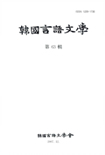- 영문명
- Remarks on the Discourse Marker ‘ㅣ’ in Middle Korean
- 발행기관
- 한국언어문학회
- 저자명
- 이희두(Lee Heedoo)
- 간행물 정보
- 『한국언어문학』韓國言語文學 第63輯, 79~103쪽, 전체 25쪽
- 주제분류
- 어문학 > 한국어와문학
- 파일형태
- 발행일자
- 2007.12.30

국문 초록
영문 초록
The addition of ‘ㅣ’ at the end of the verb final stem, the name of persons and animals were very productive in Middle Korean. However the reason and mechanism of the addition of ‘ㅣ’ were not explicitely explained yet. In this paper I suggested that ‘ㅣ’ was a discourse marker which increased the familiarity and efficiency of a communication. This marker did not change the propositional meaning and the category of part of speech and then I also insisted that it was a linguistic element on the level of a spoken language, not a written language.
This discourse marker was first emerged after the name of persons by way of the grammaticalization of the subject marker ‘ㅣ’. A grammaticalization did expand the grmmatical properties by the change from a lexical status to grammatical status, from a derivational forms to a inflectional forms, from the less grammaticl forms to the more grammatical forms. However all the lexical items were not grammaticized but only a few of the lexical items were according to the usage frequency. On the basis of this point of view, a syntagmatic structure ‘personal name+subject marker ‘ㅣ’’ which had a high usage frequency was grammaticized by a psychological reanalysis and so the concept of grammatical relation of the subject marker was abstractively changed to the familiar relations of the discourse marker.
Whenever this discourse marker ‘ㅣ’ was additioned to the final vowel of stems, a falling dipthongs were appeared owing to the vowel system of that time. Through a 18C this vowel system was drastically changed by a monothongization. As the result of this vowel change the discourse marker ‘ㅣ’ was developed to the feature [fronted] by the more grammaticalization and then this discourse marker feature of the contemporary Korean has been addited to the word initial on the contrary to the Middle Korean.
This discourse marker was first emerged after the name of persons by way of the grammaticalization of the subject marker ‘ㅣ’. A grammaticalization did expand the grmmatical properties by the change from a lexical status to grammatical status, from a derivational forms to a inflectional forms, from the less grammaticl forms to the more grammatical forms. However all the lexical items were not grammaticized but only a few of the lexical items were according to the usage frequency. On the basis of this point of view, a syntagmatic structure ‘personal name+subject marker ‘ㅣ’’ which had a high usage frequency was grammaticized by a psychological reanalysis and so the concept of grammatical relation of the subject marker was abstractively changed to the familiar relations of the discourse marker.
Whenever this discourse marker ‘ㅣ’ was additioned to the final vowel of stems, a falling dipthongs were appeared owing to the vowel system of that time. Through a 18C this vowel system was drastically changed by a monothongization. As the result of this vowel change the discourse marker ‘ㅣ’ was developed to the feature [fronted] by the more grammaticalization and then this discourse marker feature of the contemporary Korean has been addited to the word initial on the contrary to the Middle Korean.
목차
1. 머리말
2. 담화표지 ‘이’의 발생과 문법화
3. 담화표지 ‘이’의 쓰임과 기능
4. 맺음말
〈참고문헌〉
[Abstract]
2. 담화표지 ‘이’의 발생과 문법화
3. 담화표지 ‘이’의 쓰임과 기능
4. 맺음말
〈참고문헌〉
[Abstract]
해당간행물 수록 논문
참고문헌
최근 이용한 논문
교보eBook 첫 방문을 환영 합니다!

신규가입 혜택 지급이 완료 되었습니다.
바로 사용 가능한 교보e캐시 1,000원 (유효기간 7일)
지금 바로 교보eBook의 다양한 콘텐츠를 이용해 보세요!


